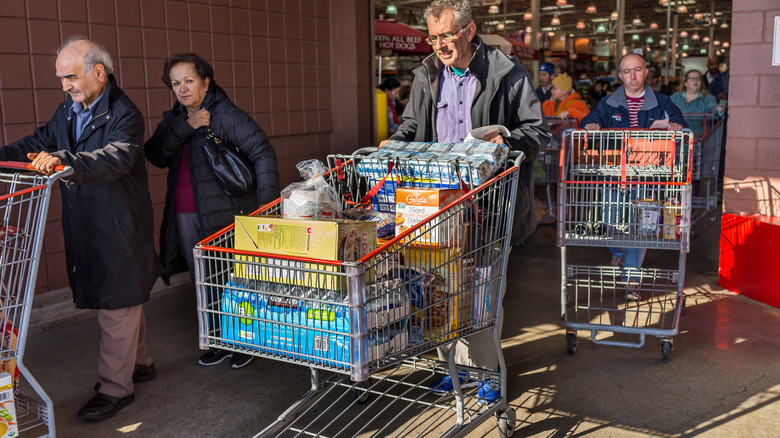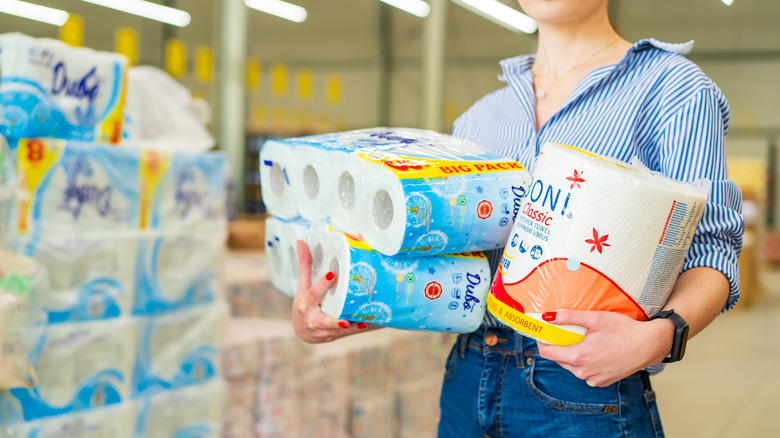Household Items Homeowners Are Stocking Up On In Anticipation Of Tariffs
It seems like the word "tariff" is currently on everyone's tongue. No matter what side of the political aisle you're on, you may have heard that as tariffs go into effect, you're likely to see price increases on goods in many aisles at your favorite grocery, big box, and home improvement stores. Simply put, a tariff is a tax one country puts on imports from another. Earlier this month, the new Administration announced sweeping tariffs on countries including Canada, Mexico, and China. Recently, President Trump proclaimed that steel tariffs will apply to all countries. Because the United States is the largest importer of goods in the world, experts believe the new tariffs will strongly impact consumer pricing with costs expected to rise. From paper goods to aluminum foil to appliances to tools, there are many household items homeowners are stocking up on in anticipation of tariffs.
The American supply chain is extremely complex and involves not just the import of readymade goods that you can use right off the shelf but also the raw materials used to produce those items. For example, the wood pulp used in the Charmin Toilet Paper manufacturing process comes from Canada. The high-tech Ryobi tools that make work in your home and garden a breeze are assembled in South Carolina using die-cast steel imported from China and Mexico. Your favorite aluminum kitchen utensils are typically imported from India, China, and Sri Lanka. And of course, a variety of perishable items come from around the globe.
Toilet paper and aluminum foil
So what everyday items are people stocking up on in anticipation of tariffs? The first is paper goods. Must-have items like paper towels, toilet paper, and tissues made from imported wood pulp will soon be more expensive for manufacturers to bring into their plants. Shoppers will also remember that these items, toilet paper in particular, were subject to panic buying and hoarding during the COVID-19 pandemic. Since shelter-in-place restrictions will not be a factor as tariffs are implemented, you probably won't see any increase in the amount of paper products your family typically uses. However, there are benefits to buying toilet paper in bulk, along with paper towels and tissue, so some homeowners are making space in their storage closet for a few extra rolls or boxes before prices increase.
Aluminum foil is another everyday item many people are stocking up on. The United States is heavily reliant on imports from countries including Canada, China, Malaysia, Germany, and Turkey. Whether you love it for wrapping up leftovers or use aluminum foil hacks to get a cleaner home, expect to see a significant price increase as aluminum tariffs go into effect. If you frequently use disposable aluminum cake pans, know that some are stocking up on those, too. Many of them are imported from China. Because it was discovered that aluminum containers, pans, trays, and lids were sold into America at unfair value prices, duty adjustments are likely to increase the prices you'll see at your local grocery store in the months ahead.
Appliances and furniture
There are some major purchases people are also keeping in mind as steel tariffs go into effect. The United States is heavily reliant on steel imports, with many imports coming from Canada, Mexico, Germany, South Korea, and Japan. Canada supplies a large portion of that steel, thanks to production capacities that were developed around its natural supply of iron ore and its close proximity to the States. Steel is the backbone of a wide range of items, from cars and tools to outdoor storage sheds and even new homes.
Found in appliances, furniture, floor joists, and countless other items, price hikes as a result of steel tariffs may reframe some of your upcoming purchases, such as a new refrigerator or stove. The same goes for that new steel-reinforced patio furniture set or those high-end backyard sheds that can increase your resale value. The United States is also the largest importer of hand tools in the world, so items used to DIY a basic household tool kit may also be purchased more frequently before prices rise.
Those looking for a new home may also be eager to buy. Building materials will be significantly impacted by tariffs, with home construction prices likely to increase by up to 6% (per CoreLogic analytics), driving the cost of new homes up. Stabilizing prices and higher inventory are great news for anyone buying in 2025, but that may change in the months and years ahead.


